Mammals of the Adirondacks:
Gray Fox (Urocyon cinereoargenteus)

The Gray Fox (Urocyon cinereoargenteus) is an omnivore with grizzled gray fur and a black-tipped tail. It is found in deciduous and mixed forests in the Adirondacks.
- The Gray Fox is one of three members of the dog family (Canidae) that live in the Adirondack Park; the other two are the Red Fox (Vulpes vulpes) and the Eastern Coyote (Canis latrans var).
- Like other North American foxes, Gray Foxes are considered to be meso-predators, because they co-exist with larger predators, such as American Bear and Eastern Coyotes, that sometimes prey on them.
- The genus name (Urocyon) is said to be a combination of the Greek oura (tail) and cyon (dog), or dog-tail. The species name (cinereoargenteus) is derived from the Latin words for ashy-silver.
- Other names for the Gray Fox include Common Gray Fox, Grey Fox, Maned Fox, and Tree Fox. The latter name is a reference to this species' tree-climbing ability. The name Maned Fox is derived from the stiff, mane-like hairs running down the Gray Fox's tail.
Gray Foxes are one of six North American fox species. They represent a distinct evolutionary lineage from Red Foxes (which also are found in the Adirondacks). The Gray Fox's ancestors reportedly separated from other canid species 3.6 million years ago.
Seven subspecies of Gray Foxes are recognized in North America, with an additional eight subspecies occurring in Central and South America. The Gray Fox that lives in our region is probably Urocyon cinereoargenteus borealis.
Gray Fox: Description
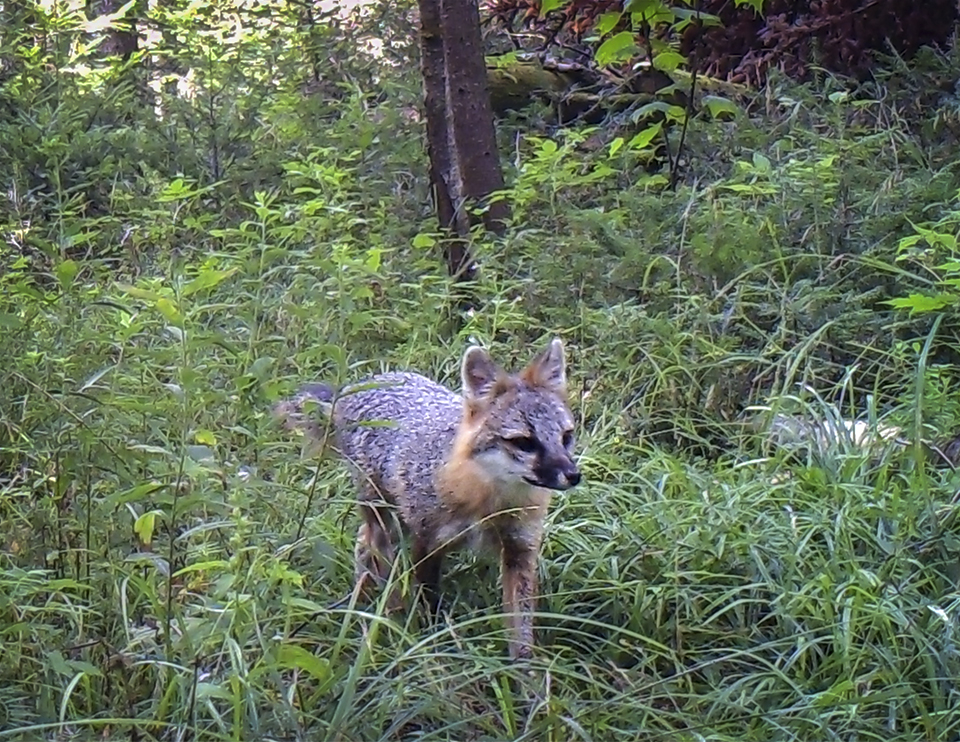
Gray Foxes are housecat-sized mammals with a long, bushy tail that makes them look somewhat larger than they actually are. The head and body are 23-26 inches long; the tail is 12-15 inches long. The height at the shoulder is about 14 inches. Gray Foxes weigh from seven to 13 pounds.
There is significant regional and individual variation in size. Gray Foxes in the northern parts of their range tend to be somewhat larger than those in the south. Males are normally 5-15% larger than females. Individuals from the northern parts of their range are said to be more colorful than those in the southern areas.
The upper body of the Gray Fox appears a grizzled gray, due to the individual guard hairs being banded with white, gray, and black. The neck and lower sides are cinnamon brown. The underparts are white or tan. The upper surface of the tail is gray and has a prominent black stripe of coarse, mane-like hairs running to the tip. The legs are white and gray, with rusty highlights. The Gray Fox has rather short legs, giving these foxes a stocky appearance. Gray Foxes do not appear to have color phases, unlike the Red Fox, which has a black or silver phase (more common in the colder parts of its range.)
The Gray Fox has distinct black, white, and rufous facial markings.
- There is a black stripe which runs from the outside corner of the eye to the side of the head.
- The fur around the nose and on the cheeks is white, contrasting with a black whisker patch.
- The color of the iris varies. A review of close-up photographs of Gray Foxes on the internet suggests that most adult Gray Foxes have gray or grayish-brown eyes, although a few adults (and the young Gray Fox litter shown here) have blue eyes.
Gray Foxes share many diagnostic characteristics with other North American foxes, including the Red Fox. However, Gray Foxes are stockier in appearance than the Red Fox and have relatively shorter legs. Moreover, while Red Foxes have a distinct white tip on their tails, the tip of the Gray Fox tail is black. The Gray Fox also has a shorter muzzle than the Red Fox. Another difference is in the eyes; Red Foxes have slit-like pupils, while the pupils of Gray Foxes are oval in shape.
Gray Fox: Diet
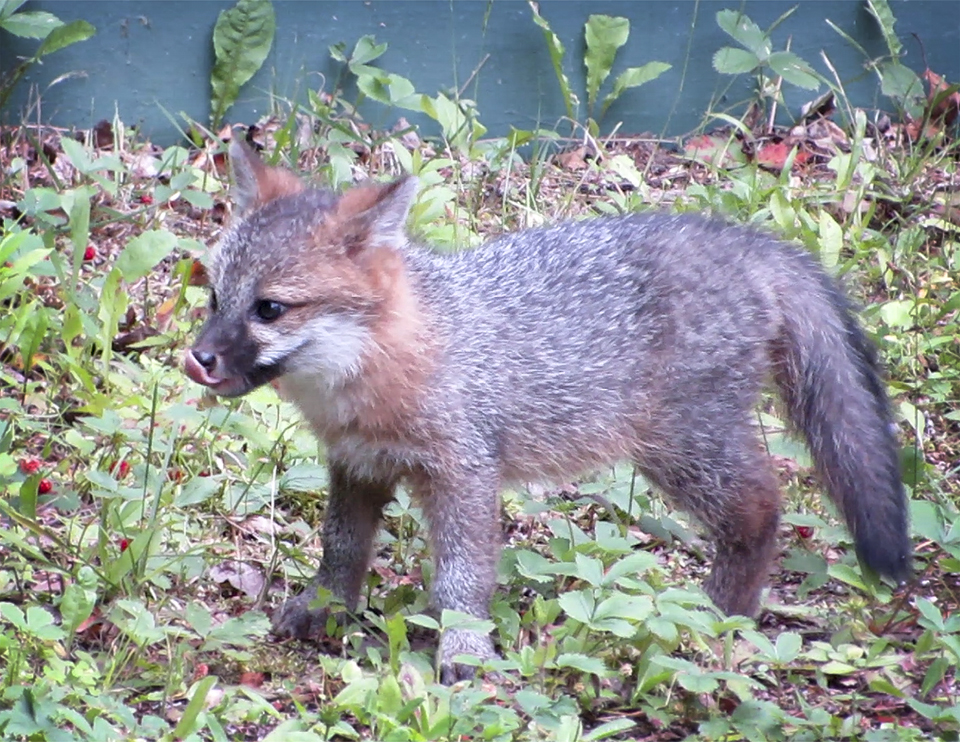
Gray Foxes are opportunistic omnivores whose diet varies with the season and the availability of prey and plant material.
- Gray Foxes feed mainly on small mammals, including Red Squirrels, Gray Squirrels, Eastern Chipmunks, mice, and voles.
- In some areas, the Eastern Cottontail is the most important food item. As Snowshoe Hares are the main "rabbit" throughout much of the Adirondack Park, it is probable that hares form a staple in the Gray Fox diet in our region, particularly in winter.
- Gray Foxes also prey on birds (such as Ruffed Grouse), reptiles, and amphibians.
- This species also consumes carrion, such as winter-killed White-tailed Deer.
- Insects such as grasshoppers, beetles, butterflies, and moths are said to be the preferred invertebrates.
Gray Foxes are the most omnivorous of North America's canids, relying to a greater extent than Eastern Coyotes or Red Foxes on plant material year-round, particularly in summer and fall. Fruit (such as common wild strawberries, apples, and huckleberries) and nuts (including acorns and beech nuts) are some of the plant items on the Gray Fox menu.
Gray Fox: Reproduction and Family Life
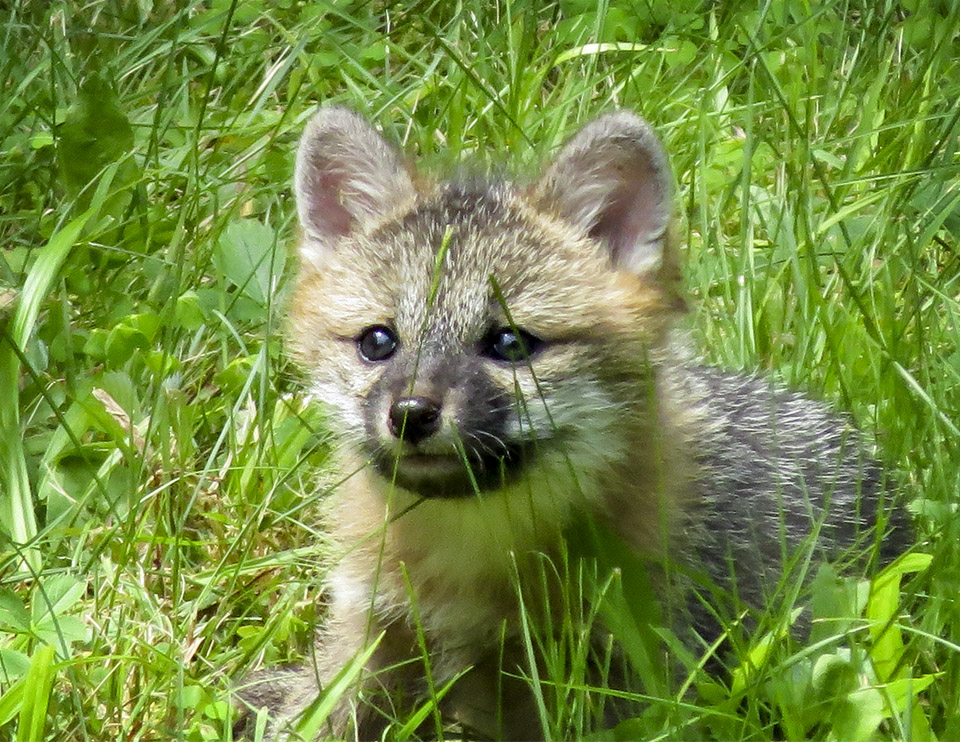
Gray Foxes breed once yearly. Like the other five North American fox species, this species is said to be basically monogamous, although this has not been documented in the case of Gray Foxes.
Gray Foxes raise their young in dens, which may consist of a hollow tree or log. They may also den in wood piles, brush piles, and rock crevices, or under rocks, outbuildings, or abandoned houses. Gray Foxes may also use underground dens, but these are usually the converted dens of other animals, such as Woodchucks. Dens are usually located in brushy or wooded areas near a source of water.
Gray Foxes throughout their range are said to mate from late winter to early spring, two to four weeks later than Red Foxes. The timing varies with latitude and elevation, with breeding occurring earlier in the south and later in the north. There are conflicting reports on gestation period, with reported estimates ranging from 53 to 63 days. Young (variously described as "pups" or "kits") are born in late March or April, with a mean litter size of around four.
The timing of the mating season for Gray Foxes in the Adirondacks has not been documented. A 1949 study of reproductive behavior of foxes in New York State (Sheldon, 1949) focused on data from animals taken in east-central, central, and eastern New York; it did not cover northern New York.
- The author found that Gray Fox males breed from mid-January to mid-May, with 71% of Gray Foxes mated between the last week in February and mid-March.
- An examination of 90 female Gray Foxes suggested that 80% of the Gray Foxes had whelped by May.
A 1956 study of fox reproduction in New York State included data on northern New York and the Adirondacks, although there were few records for Gray Foxes in the northern regions. This study confirmed earlier findings that the Gray Fox breeding season occured later than that of the Red Fox, extending from the third week of January to the end of May. Over half of the Gray Fox matings were calculated to have taken place in March.
Young Gray foxes nurse for over three weeks, with weaning said to be complete at about six weeks. The parents (primarily the female) start bringing solid food to the young before they are completely weaned. At about three months, young Gray Foxes leave the den, start practicing their pouncing and stalking skills, and begin hunting with the female.
By four months, the young foxes are said to become independent. From breeding season through late summer, the parents with their young live as a family unit. Families reportedly disperse in the autumn when the young foxes are nearly full-grown.
Gray Fox: Behavior
The Gray Fox does not hibernate; it is active throughout the year. Like other North American fox species, the Gray Fox is primarily nocturnal. They generally have a daytime resting area in a tree or in a site with dense vegetation, leaving it at twilight or night to forage. While Gray Foxes may also hunt during the day, activity levels generally decrease sharply at sunrise.
Home ranges vary, depending on habitat structure and available food supply. Gray Foxes, like other North American foxes, mark their home ranges with urine and feces to advertise ownership and sexual status.
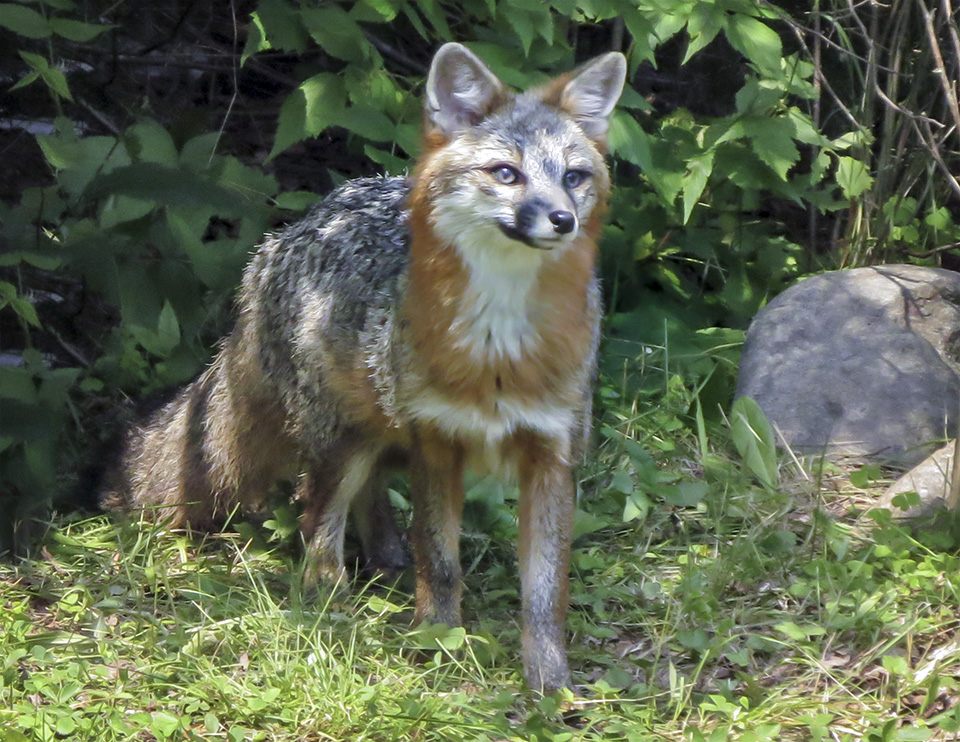
While some sources claim that Gray Foxes are secretive, other evidence suggests that they can sometimes exhibit a fair level of tolerance for humans and human-modified environments. A study on the ecological niche of coyotes in the Adirondacks compared the response of four species to human activities: Bobcats, Eastern Coyotes, Red Foxes, and Gray Foxes. The researchers found that Red Foxes were the most tolerant of human activity and Bobcats the least tolerant, with Eastern Coyotes and Gray Foxes in between.
Unlike Red Foxes, Gray Foxes are agile climbers, although not as skilled as a Raccoon or cat. Gray Foxes ascend trees to forage, rest, and escape predators. Their tree-climbing ability stems from their sharp, recurved claws and their ability to rotate their foreleg more than other canids, giving them a better grip when climbing tree trunks.
Like other North American foxes, Gray Foxes communicate through a variety of vocalizations, including growls, barks, whines, whimpers, squeals, yips, and yaps. The Gray Fox vocalization most commonly heard is a hoarse bark very similar to that of a Red Fox, usually heard at night. Young Gray Foxes appear to communicate mainly with squeals and high-pitched yips and yiks.
Gray Fox: Mortality and Predators
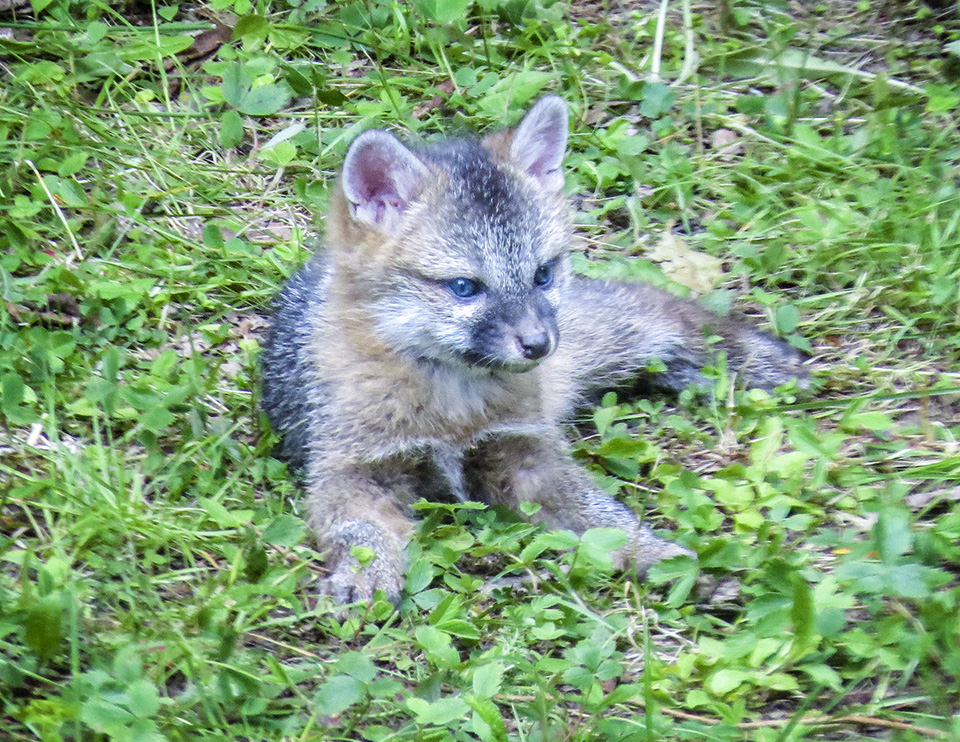
The primary predator of the Gray Fox is man. Hunting and trapping are legal throughout most of the Gray Fox's range. In many areas, this is the major cause of mortality.
- In New York State, the Gray Fox is one of ten species of furbearers that may be hunted. Hunting is allowed from 25 October to 15 February, at any hour of the day or night, using handguns, shotguns, rifles, bows, or crossbows. A hunting license is required. Hunters who kill Gray Foxes are not required to submit a report. There is no limit on the number of Gray Foxes killed in this way.
- Trapping of the Gray Fox (with body-gripping traps) is legal in New York State from 25 October to 15 February. Trappers are required to take a mandatory trapper education course to obtain a trapping license. Trappers who kill Gray Foxes are not required to submit a report. There is no limit on the number of Gray Foxes killed with traps.
- A 1982 study of Gray Foxes and Red Foxes captured, tagged, and released in Cayuga County (western New York) found that trapping was the principal cause for both species.
- Given the lack of reporting requirements, it is difficult to assess the number of Gray Foxes currently killed by hunters and trappers in New York State. However, a 2018 DEC survey of small game hunters estimated the total number of Gray Foxes killed by hunters at 3,667.
Gray Foxes have few non-human predators in the wild. Adult Gray Foxes may occasionally be killed by the much larger Eastern Coyote. Young Gray Foxes may occasionally be taken by Eastern Coyotes, Bobcats, and large raptors such as Great Horned Owls. The Gray Fox's ability to evade predators by climbing trees may be useful in allowing them to occupy the same habitats as Eastern Coyotes.
Disease appears to be a less important mortality factor than human predation. In contrast to the Red Fox, the Gray Fox has a natural resistance to sarcoptic mange. Although some cases of rabies have been reported in the species, the main disease affecting the Gray Fox is canine distemper.
Gray Foxes are said to live for six to eight years in the wild. The oldest recorded Gray Fox living in the wild was ten years old at the time of capture.
Gray Fox: Distribution
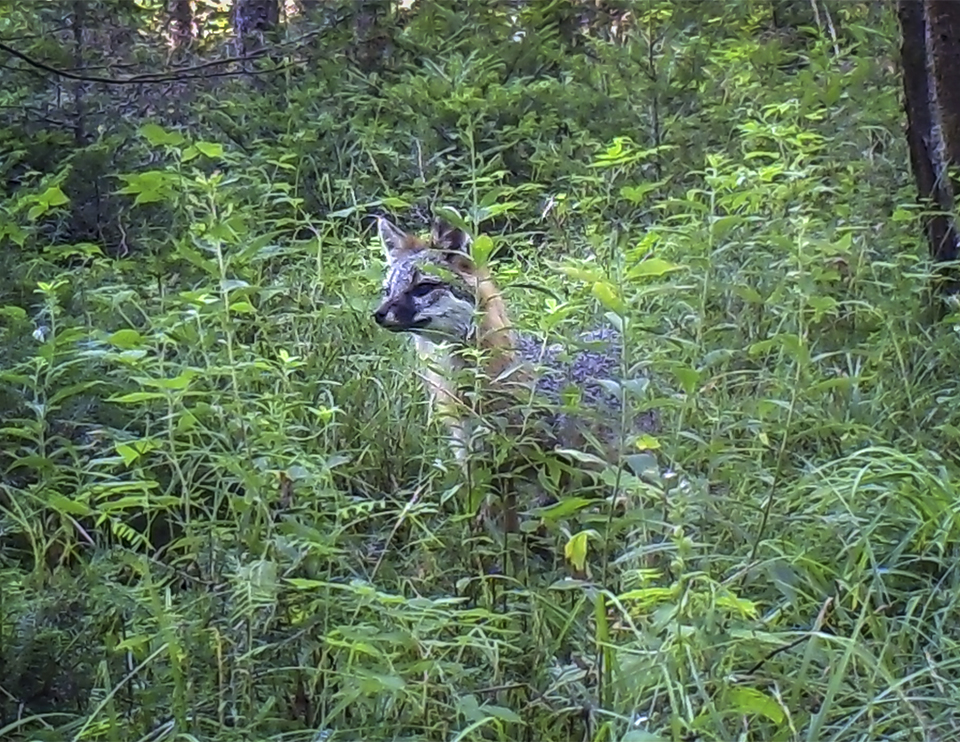
The range of the Gray Fox has shifted several times over the last four centuries. Archaeological evidence from the time preceding European settlement of eastern North America indicates that this species was found in southern Ontario, northern New England, some of the Great Lakes states, and northern New York, including the Adirondacks.
However, about 350 years ago, the Gray Fox disappeared from the northern part of its range. It is thought that Gray Foxes were extirpated from Canada around the time of European contact. Gray Foxes were not reported again until the 1890s.
There are several possible explanations. One hypothesis it that the disappearance of the Gray Fox from the northern parts of its range in Canada and the northeastern US was due to cooler temperatures associated with the Little Ice Age (1500 to 1850). Another is that the clearing of land for agriculture limited preferred Gray Fox habitat.
In any event, Gray Foxes began to make a comeback in the northeastern US during the 20th century. In the 1930s and 1940s, the Gray Fox started to expand its range north, re-occupying areas in New England, northern New York, and parts of Canada that were once parts of its historic range.
- In the Adirondack region of New York State, the earliest records of the Gray Fox in the 20th century are from the 1930s and 1940s. A Gray Fox was trapped in Washington County in 1934 and another in Essex County in 1938.
- The Gray Fox spread northward rapidly in the following decade. A few Gray Foxes were reported in Franklin County in the early 1940s.
The reestablishment of the Gray Fox in the northern parts of its range may have been due to warming temperatures. Another possibility is that abandoned fields in the region were starting to be reforested, creating more advantageous habitat.
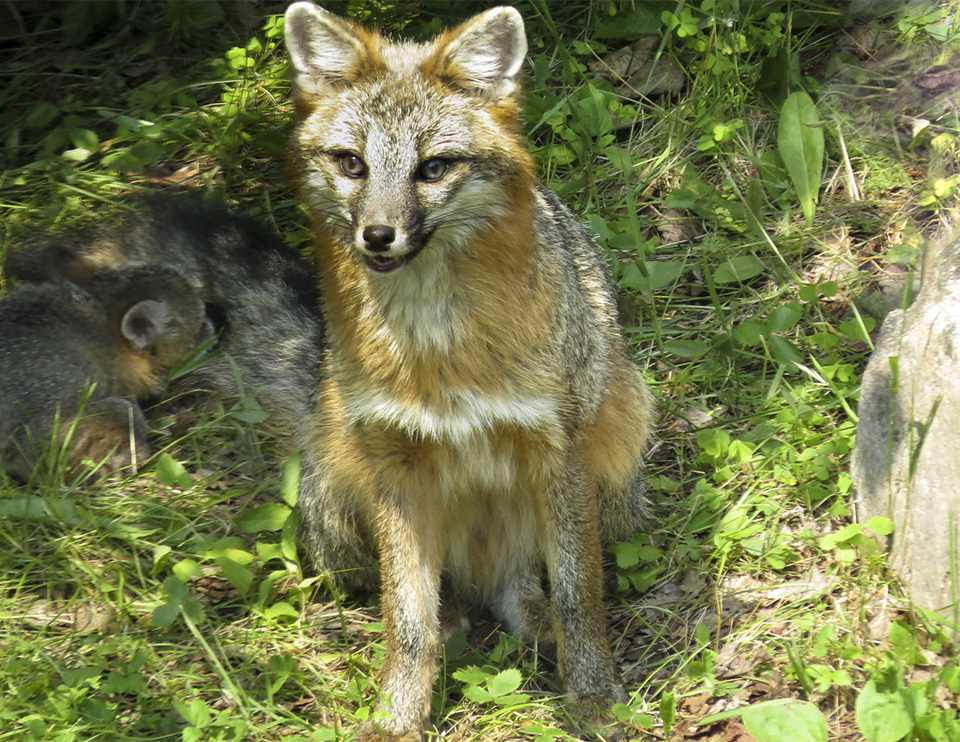
The current range of the Gray Fox is from the northern tip of South America to the extreme southern parts of Eastern Canada. Their range excludes part of the Great Plains and the mountainous regions of northwestern United States, but includes all of the eastern United States, including most of New England (except for northern and eastern Maine), Michigan, Minnesota, Iowa, North Dakota, South Dakota, Nebraska, Kansas, Oklahoma, and Utah.
The Gray Fox is found in most parts of New York State and is seen throughout the Adirondack region.
- The map of the Adirondack Park provided in Saunders' 1988 study of Adirondack mammals shows the Gray Fox present presence in all townships within the Adirondack Park Blue line except Long Lake Township in Hamilton County and North Hudson Township in Essex County. The maps are based on museum records and hunter and trapper harvest records from the New York State Department of Environmental Conservation, and probably reflect the Gray Fox's range in the 1970s and 1980s.
- Most treatments of the Gray Fox in the Adirondacks suggest that it is less commonly seen within the Blue line than the more cold-hardy Red Fox.
- The Gray Fox is said to be most plentiful in the southern Adirondacks and the Champlain and St. Lawrence Valleys.
Other sources suggest that the Gray Fox has been able to expand its range in the Adirondacks in part because of old field succession. The species is said to have benefited as maturing forests provide the Gray Fox opportunities to capitalize on its tree-climbing ability to evade predation by Eastern Coyotes. I was unable to locate studies that tested these hypotheses.
Gray Fox Habitat
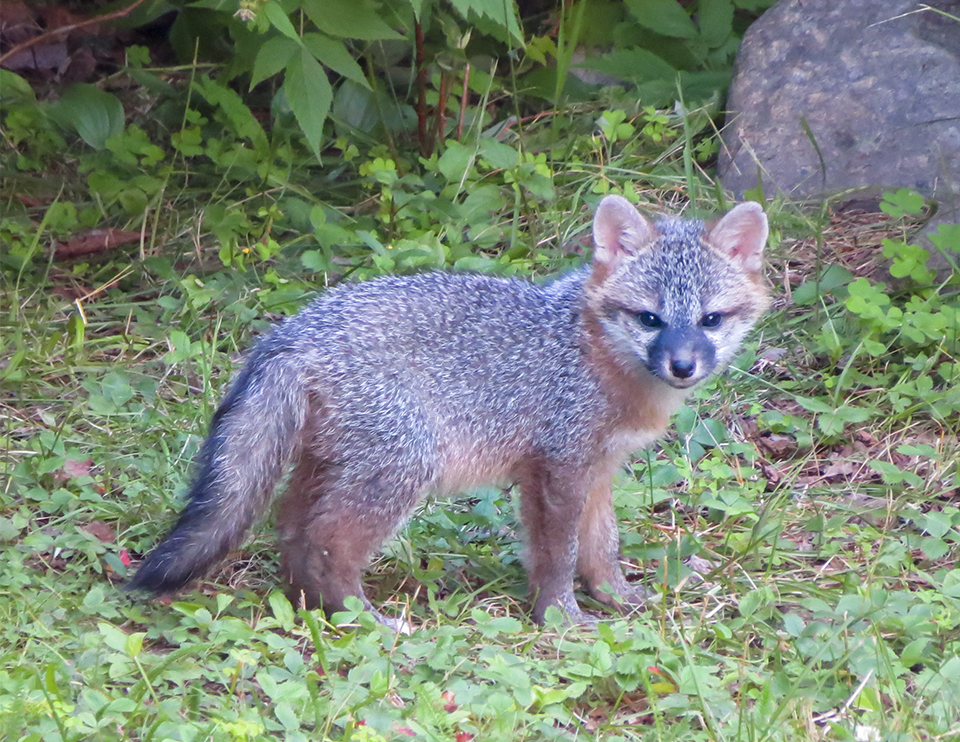
Gray Foxes throughout their range are considered habitat generalists and may make their homes in a variety of forest types. In contrast to the Red Fox, which prefers forest openings, meadows and farmlands, the Gray Fox prefers woodlands over open habitat.
Gray Foxes are most closely associated with deciduous forests, but are also found in mixed and coniferous forests in the northeast. Preferred habitat may include thickets, swamps, and old fields bordering extensive forested areas.
Where to See the Gray Fox in the Adirondacks
The most convenient way to see a Gray Fox up close and learn more about the species is by a visit to the Adirondack Wildlife Refuge and Rehabilitation Center in Wilmington. The Refuge takes in and rehabilitates injured or disabled wildlife. It is currently home to a male Gray Fox named Merry. Knowledgeable staff members, who have had longterm contact with this animal, are on hand to provide background information on the species and answer visitor questions. The refuge also has a Red Fox named Pippin, providing an opportunity to compare and contrast the two fox species.
Catching a glimpse of a Gray Fox in the wild is a chancier venture, since Gray Foxes are mostly nocturnal and somewhat secretive.
- Winter offers the best time to see Gray Fox tracks. Gray Foxes are said to be active in late winter; and snow cover provides a canvas for animal tracks.
- In terms of actually seeing a Gray Fox in the wild, the months of June and July probably offer the best chances. By this time, the young are being weaned; and the parents are more likely to be out and about during daytime hours, seeking food for their growing offspring.
During the breeding cycle, Gray Foxes are most likely to be seen leaving and returning from their dens, so nature watchers in search of a fox might want to pay close attention to likely den sites in preferred Gray Fox habitat (deciduous and mixed woods forest). This includes hollow logs, wood piles, brush piles, and openings under outbuildings and abandoned houses.
Adirondack Mammal List
References
New York State Department of Environmental Conservation. Gray Fox. Retrieved 28 March 2017.
New York State Department of Environmental Conservation. Raccoon, Red Fox, Gray Fox, Skunk, Coyote, Opossum, and Weasel Trapping Seasons. Retrieved 23 January 2019.
New York State Department of Environmental Conservation. Raccoon, Red & Gray Fox, Skunk, Opossum & Weasel Hunting Seasons. Retrieved 23 January 2019.
State University of New York. College of Environmental Science and Forestry. Gray Fox. Urocyon cinereoargenteus Schreber. Retrieved 20 January 2019.
Wildlife Exposure Factors Handbook. Office of Research and Development. EPA/600/R-93/187 (December 1993). p. 2-223. Retrieved 17 January 2019.
Janet Sullivan, Urocyon cinereoargenteus in Fire Effects Information System (FEIS). Species Reviews. Forest Service, Rocky Mountain Research Station, Fire Sciences Laboratory (United States Department of Agriculture, 1996). Retrieved 20 January 2019.
Erik K. Fritzell and Kurt J. Haroldson, “Urocyon Cinereoargenteus,” Mammalian Species, Number 189 (23 November 1982), pp. 1–8. Retrieved 21 January 2019.
Integrated Taxonomic Information System On-line Database. Urocyon cinereoargenteus. Retrieved 21 January 2019.
G. Roemer, B. Cypher, & R. List. 2016. Grey Fox. Urocyon cinereoargenteus. The IUCN Red List of Threatened Species 2016. Retrieved 21 January 2019.
University of Michigan. Animal Diversity Web. Gray Fox. Urocyon cinereoargenteus. Retrieved 21 January 2019.
The Nature Conservancy. Laurentian-Acadian Northern Hardwood Forest. Retrieved 17 February 2020.
The Nature Conservancy. North-Central Interior Beech-Maple Forest. Retrieved 17 February 2020.
iNaturalist. Adirondack Park Observations. Gray Fox. Urocyon cinereoargenteus. Retrieved 18 February 2020.
D. Andrew Saunders. Adirondack Mammals (Adirondack Wildlife Program. State University of New York. College of Environmental Science and Forestry, 1988), pp. 156-159.
William K. Chapman. Mammals of the Adirondacks. A Field Guide (North Country Books, 1991), pp. 89, 92-94, 141, Plate 14.
John O. Whitaker, Jr. and William J. Hamilton, Jr. Mammals of the Eastern United States (Cornell University Press, 1998), pp. 419-422.
Alexander C. Martin, Herbert S. Zim, and Arnold L. Nelson. American Wildlife & Plants. A Guide to Wildlife Food Habits (Dover Publications, 1951), pp. 227, 294-295, 297-298, 321, 331, 345-346, 350-351,355-356, 392, 468-469.
James M. Ryan. Adirondack Wildlife. A Field Guide (University of New Hampshire Press, 2008), pp. 209-210.
William Henry Burt. A Field Guide to the Mammals of North America North of Mexico. Third Edition (Houghton Mifflin Company, 1980), pp. 68-69, 75-77. Retrieved 22 January 2019.
Luigi Boitani and Stefania Bartoli. Simon & Schuster's Guide to Mammals (Simon & Schuster, 1982), p. 249. Retrieved 22 January 2019.
National Geographic Society. Wild Animals of North America (National Geographic Society, 1995), p. 231.
Adrian Forsyth. Mammals of North America. Temperate and Arctic Regions. (Firefly Books, 1999), pp. 180-181.
Richard M. DeGraaf and Mariko Yamasaki. New England Wildlife: Habitat, Natural History, and Distribution (University Press of New England, 2001), pp. 343-344, 420, 454. Retrieved 22 January 2019.
Bryan L. Cypher, "Foxes. Vulpes species, Urocyon species, and Alopex lagapus," in George A. Feldhamer, Bruce C. Thompson, and Joseph A. Chapman (Eds). Wild Mammals of North America: Biology, Management, and Conservation. Second Edition (The Johns Hopkins University Press, 2203) pp. 511-546.
Clayton B. Seagears. The Fox in New York. An Educational Bulletin (New York State Conservation Department, 1944), pp. 7-37.
Thomas G. Scott, "Dietary Patterns of Red and Gray Foxes," Ecology, Volume 36, Number 2 (April 1955), pp. 366-367. Retrieved 19 January 2019.
Scott A. Warsen. Evolving Niche Of Coyotes In The Adirondack Mountains of New York: Long-Term Dietary Trends and Interspecific Competition. A thesis submitted in partial fulfillment of the requirements for the Master of Science Degree State University of New York, College of Environmental Science and Forestry (Syracuse, New York. May 2012). Retrieved 18 January 2019.
Tom Kalinowski, "Adirondack Wildlife: The Gray Fox," Adirondack Almanack, 21 August 2013. Retrieved 19 January 2019.
Ellen Rathbone, "The Red and The Grey – A Look at Adirondack Foxes," Adirondack Almanack, 23 January 2010. Retrieved 19 January 2019.
Meghan McCarthy McPhaul, "Tree Climbing Adirondack Foxes," Adirondack Almanack, 25 June 2015. Retrieved 19 January 2019.
Meghan McCarthy McPhaul, "Adirondack Foxes Are Active in Late Winter," Adirondack Almanack, 22 March 2017. Retrieved 19 January 2019.
David Alderton. Foxes, Wolves and Wild Dogs of the World (Blandford, 1998), pp. 122-125. Retrieved 22 January 2019.
William J. Hamilton and John O. Whitaker, Jr. Mammals of the Eastern United States. Second Edition (Cornell University Press, 1979), pp. 270-272. Retrieved 22 January 2018.
Northeastern States Research Cooperative. Adirondack Study Exposes Evolving Niche of the Coyote in Northeastern Forests. Retrieved 19 January 2019.
Donald Mcalpine, James D. Martin, and Cade Libby, "First Occurrence of the Grey Fox, Urocyon cinereoargenteus, in New Brunswick: a Climate-change Mediated Range Expansion? " The Canadian Field-Naturalist, Volume 122, Number 2 (2008). Retrieved 19 January 2019.
William G. Sheldon, "Reproductive Behavior of Foxes in New York State," Journal of Mammalogy, Volume 30, Number 3 (August 1949), pp. 236-246. Retrieved 20 January 2019.
Stephen H. Richards and Ruth L. Hine. Wisconsin Fox Populations. Technical Bulletin. Wisconsin Department of Natural Resources, Number 6. (Madison, Wisconsin: Game Management Division, Wisconsin Conservation Department, 1953). Retrieved 27 January 2019.
Government of Canada. Species at Risk Public Registry. Species Profile. Gray Fox. 2018-09-19. Retrieved 23 January 2019.
Environment and Climate Change Canada. 2017. Recovery Strategy for the Grey Fox (Urocyon cinereoargenteus) in Canada [Proposed]. Species at Risk Act Recovery Strategy Series. Environment and Climate Change Canada, Ottawa. Retrieved 24 January 2019.
Committee on the Status of Endangered Wildlife in Canada (COSEWIC). Assessment and Status Report on the Gray Fox (Urocyon cinereoargenteus) in Canada (Ottawa, 2015). Retrieved 22 January 2019.
Cornell Lab of Ornithology, Ithaca, New York. Birds of North America. Subscription Web Site. Ruffed Grouse, Wild Turkey, Wood Duck, Song Sparrow. Retrieved 28 January 2019.
David Figura. DEC survey: What animals are most popular among New York's small game hunters? Retrieved 28 January 2019.
James N. Layne and Warren H. McKeon, “Some Aspects of Red Fox and Gray Fox Reproduction in New York,” New York Fish and Game Journal, Volume 3, Number 1 (January 1956), pp. 44-74. Retrieved 1 February 2021.
Benjamin F. Tullar, Jr. and Louis T. Berchielli, Jr., “Comparison of Red Foxes and Gray Foxes in Central New York With Respect to Certain Features of Behavior, Movement and Mortality,” New York Fish and Game Journal, Volume 29, Number 2 (July 1982), pp. 127-133. Retrieved 1 February 2021.
